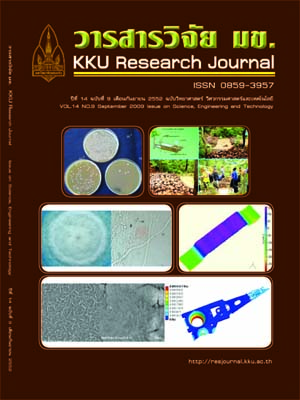Use of random amplified polymorphic DNA marker for characterization of usarium wilt pathogen of tomato (Fusarium oxysporum f.sp. lycopersici) (Thai)
Main Article Content
Abstract
Fifteen isolates of Fusarium oxysporum f. sp. lycopersici (Fol) were collected in Thailand and 4 standard isolates from The Netherlands and The United States of America, were tested for pathogenicity using tomato seedling (Sida variety). Fourteen isolates of Fol caused Fusarium wilt symptoms on tomato plants but five isolates did not infect the host plant. The DNA of 19 isolates of Fol were subjected to random amplified polymorphic DNA polymerase chain reaction (RAPD-PCR) to compare their DNA patterns to Fusarium (F.oxysporum f.sp. melonis, F.oxysporum f.sp. cucumerinum, F.moniliforme, F.poae, F.solani and Fusarium spp. Twenty primers (Operon Kit C 20 primers) were used based on the RAPD-PCR technique. The primer OPC-04 produced DNA fractions of about 520 base pairs (bp). This fraction was found only on isolates that caused fusarium wilt disease. When using primer OPC-08, a PCR product appeared with a size of 180 bp, which was seen only in the isolates causing fusarium wilt disease. However, there were no DNA fractions of 520 and 180 bp in other Fusarium spp. tested. This result provides characterization of Fusarium wilt pathogens by the PCR technique.


